Biography

Huile sur panneau
56 x 40 cm
Exécuté en 1939 par son ami Auguste Trémont
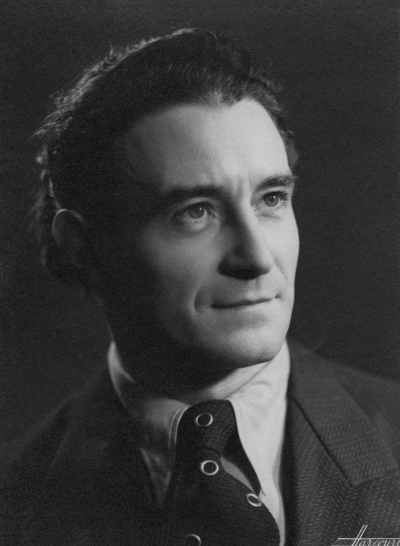
Photographie studio Harcourt
Archives familiales
Gaston Suisse was born in Paris on December 1st, 1896 and died at his Parisian home in the 13th arrondissement on March 7th 1988. He was born into a family of artists; his brother was a violinist, his father, a collector and book-lover, owned a library with over 10 000 works, including beautiful documentation on Japanese and Chinese art.
Early on he gives his son a taste for books and Far Eastern art, which will obviously become relevant to his career. Already at 5 or 6 years old, he begins to reproduce the plates in his father's books, draws his cat and proves himself to be very talented. His father will encourage him in this path, bringing him to visit all the important museums while he's very young and taking him regularly to the Jardin des Plantes, where the young Gaston Suisse will discover new models, observing the animals at length before making sketches of them. It is at the Jardin des Plantes, when he is 15 years old, that he meets Paul Jouve, already a famous, well established artist. Right away a love of animals, of observation and drawing will draw them together and mark the beginning of a long friendship. Jouve will speak with enthusiasm of the zoos in Antwerp and Hamburg where the animals are not kept in cages but can be seen in more natural surroundings, making observing them more interesting. Gaston Suisse will accompany Jouve to Antwerp two years later and there he will meet the sculptor Bugatti, a friend of Jouve's.
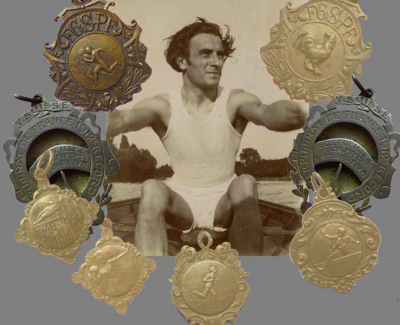
Dans les années 20, à Chatou.
Archives familiales
Archives familiales.
Passing the entrance exam for the École Supérieure des Arts Décoratifs, he will learn the basics of the lacquerer's craft. Immediately fascinated by the substance, he will never cease to learn, to document himself and experiment with it. He will obtain gold medals in 1913 and in 1914 for his first creations.
Gaston Suisse was also very athletic. He practices rowing, becomes a French champion in vaulting, in the 100 meters and in decathlon, accumulating medals up until 1913. In the summer of 1913 he will make his first trip to Algeria, then return several times, staying with relatives. These vacations, far from the intimacy of his immediate family, will significantly leave their mark on him.
Gaston Suisse posant en tireur à l'arc, dans son atelier, dans les années 30.
Il utilisera ces photos comme modèle pour ses panneaux sur la chasse à l'arc.

Armée d’Orient, Salonique
Archives familiales
13,5 x 9,5 cm
Archives familiales
Mobilised in 1914, he fights in the trenches at Verdun, then leaves with the Army of the Orient for Salonika where he will meet up with Jouve, also mobilised. Throughout the war he regularly sends sketches and notes to his school which are published in the school newspaper. The war ends, and he resumes his studies at the Ecole des Arts Décoratifs.
His personal research and essays lead him to do an extra year at the school of Applied Arts in order to perfect, among other things, gilding techniques and learn metal-oxide chemistry. One of his friends, Dang Bui, a lacquerer from Annam (today's Vietnam) brings him back the first pots of vegetal lacquer, allowing him to put his experiments into practice. Soon he masters the art of eggshell inlay and gold leaf work, and quickly develops innovative techniques, obtaining lacquers of unparalleled originality and richness. He will do research on the use of oxidation processes. Very early, in part to free himself from the constraints linked to using vegetal lacquers, Gaston Suisse uses vegetal lacquers diluted in oils or alcohol. The addition of camphor oil makes the lacquer more liquid for example and therefore easier to use.

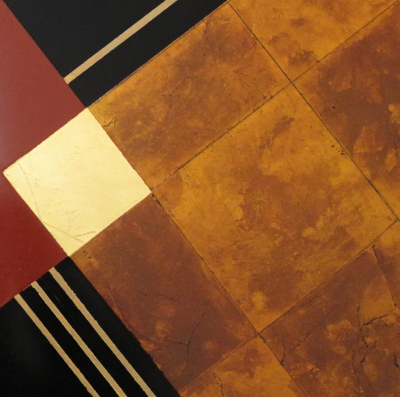
Sur fond de laque noire.
The addition of drying oils also makes it possible to reduce drying time. His research leads him to use synthetic varnishes, thus enabling him to overcome certain constraints linked to the use of vegetal lacquers. With the possibility of mixing coloured pigments to the varnish, the chromatic range available became much wider, and the drying time became considerably shorter. Although the technique remained the same, these new products made it possible to use a pistol, which meant that from then on one could directly obtain a shellacking with all the possible nuances instead of through successive sanding. It then became possible to add a multitude of components to the varnish, and create a very wide variety of effects.
Gaston Suisse then has the idea of crushing Bleak scales and adding them to the lacquer, obtaining in this way anthracite nuances of an incredible richness, giving his creations an astonishing refinement and distinction.
Merle branché, vers 1930.
Laque noire gravée, rehauts de laques polychromes.
Laque et poudre d'aluminium, sur fond de laque écaille d'ablette.
Décembre 1930

laque noire et écaille foncée.
Coquille d'oeuf en pluie.
Gaston Suisse will create Chinese lacquer furniture and objects decorated in an abstract and geometric style that become the mark of his personal research. Founding artist of what will be called the Art Déco period, Gaston Suisse will immediately encounter a huge success, he will be named a member of the Salon d'Automne after his first exhbition. The critics unanimously laud him with praise.
Here is M.Tisserand writing in the review L’Art Vivant. We point out in particular the lacquerware by Gaston Suisse. He shows lacquers over which his invention fans out magically. We are pleased to notice that they are having a huge success with the Salon's visitors. Nothing has more charm than this art treated with keen
spirit avid for discovery and M. Derys in the review Mobilier et Décoration Gaston Suisse's lacquer panels unite sumptuousness in its most fulfilled sense with the freest decorative composition also realised the quality and originality of the screens exposed that year.

De gauche à droite:
Armand Brugnaud, Lemaire,
Gaston Suisse et Paul Arzens.
Photographie d'époque, 1924.
Archives familiales.
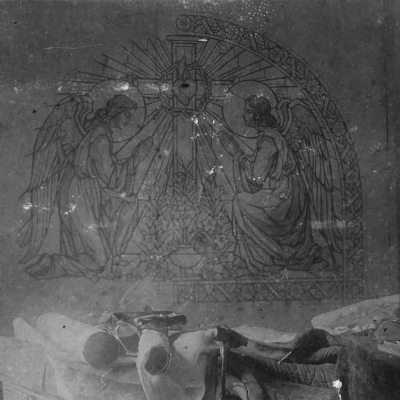
Éxécuté pour Jean Perzel.
Atelier de Gaston Suisse.
Photographie d'époque.
Archives familiales.
Gaston Suisse, among many artists at that time in fact, presented himself as a decorator. In charge of the decoration of the Alhambra in Algiers, at the end of 1924, he travels throughout the Maghreb afterward and brings back numerous sketches of antelope, gazelles, macaques monkeys, and fennecs. In early 1925, fascinated by the South, he crosses the Sahara by caravan, going as far south as Tassili in Touareg Country. Then on towards Africa from where he will bring back many studies.
Back in Paris, he creates for Maurice Dufresne the decoration for the La Maitrise Pavillon for the Galeries Lafayette. At the same time as his lacquerware production, he is creating projects for fabrics for Madame Duchesne, the cartoons for stained glass windows for Jacques Grubber, and, for his friend Jean Perzel, he designs the sets for the Opéra de Paris and costumes for the Comédie Française. He refuses all solicitations, prefers avoiding social life in the search for calm and the serenity of his atelier. It is moreover his friend Paul Jouve who will push him to expose his first creations. For an exhibition with the Group of Animalists at the Brandt gallery he draws interior gates and radiator covers that will be made of wrought iron. For the ensembliers, Jansen, Straub, Brandt, Ruhlmann and Boyer, he creates furniture and lacquered and decorated panels, and for Hermès a hundred or so lacquered boxes to be sold in the United States.

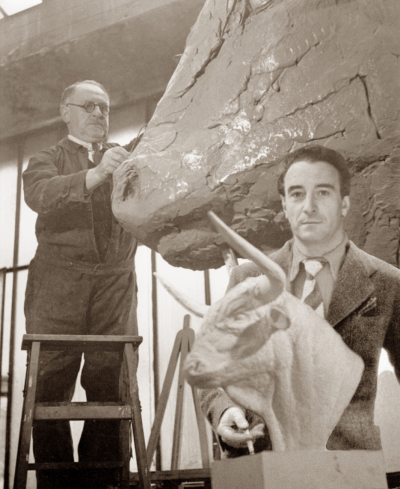
Gaston Suisse au 1er plan.
Paul Jouve au 2e plan.
Archives familiales.
His work and his thoughts are the sign of a very wide ranged culture, which he never ceases to perfect. To escape the constraints that come with the use of vegetal lacquers, he develops and uses synthetic varnishes, making it possible to obtain a wider chromatic range. This will add even more splendour to his animalist compositions. Gaston Suisse was not content representing only the flora and fauna. His extremely varied work represents, with equally happy results, landscapes, persons, and also includes huge compositions, such as the one commissioned by the city of Paris for the Exposition Internationale of 1937, currently in the Années 30 museum in Boulogne-Billancourt. On this occasion, and taking into account the monumental size of the panels to be executed for this order, he rented with his friend Paul Jouve, a very large workshop on rue Lebouis, in Paris. For this order, Gaston Suisse had to execute a set of lacquer panels, representing the arts and technique in the modernity of 1937. This set was to decorate the large gallery and the reception rooms of the municipal council. In its decor, Gaston Suisse pays tribute to the artists, aviators and companies which contribute to the international influence of France. The lacquerer inscribes his work in a spatial and temporal reality by the choice of contemporary protagonists who can be recognized by the spectators of the Palais de la Ville de Paris. This aspect of the decor is also a reminder that the place in which it is exhibited is aimed at a select audience that is particularly cultured and integrated into the artistic, political and industrial circles of the time. The work of Gaston Suisse very subtly reflects the changes that are linked to the transformation of the modern world thanks to the advance of new technologies.
Atelier de la rue Lebouis. 1936. Gaston Suisse est debout à droite.
Au fond de l'atelier on aperçois les panneaux en cours d'exécution.
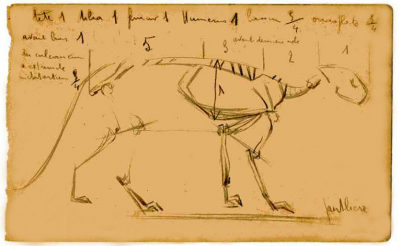
Proportion d'une panthère.

22 x 16,5 cm.
For the publication of one of its catalogues, Cécile Ritzenthaler writes : "Each of his animal portraits is no only of a perfect graphic quality but also well inscribed in the movement of the 1930. Not one specialist of this bird or that mammal can reproach Gaston Suisse of the slightest anatomic error, the observation of the model having been so precise and the relationship linking the artist and the animal so close to complicity".
Mobilised a second time during the Second World War, he is taken prisoner. He succeeds in escaping and rejoins the free zone where he is able to print false demobilisation papers and get back to Paris.
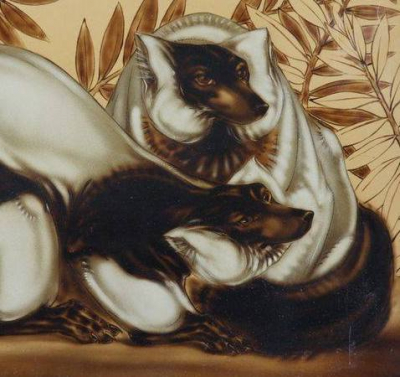
Laque polychrome.
Haut. 43 cm, Larg. 69 cm.
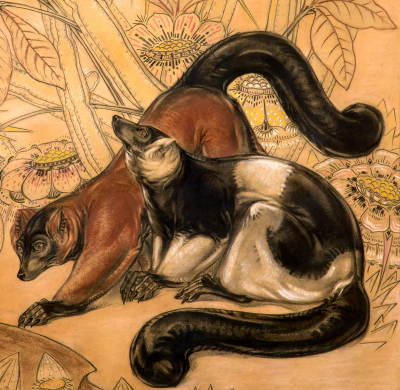
Crayon et pastel à l'huile.
Haut. 140 cm, larg. 90 cm.
He goes back to work despite the difficulties of the period. And meets the one who will become his wife, and who, although very young, already has a personality that is out of the ordinary. She had obtained, at15, the first price in the open competition in literature. Her diary is very touching, very original and anti-conformist, and reflects a maturity and exceptional strength of character for her age. In permanent revolt against her family whom she loathes, her meeting at 18 with Gaston Suisse will be determining. Gisèle will leave her family, bravely facing all taboos, she abandons preparation for the Ecole Normale Superieure to follow the man who will become her husband.
This period of the occupation was particularly difficult for the couple, with her parents having the police search for her because Gisèle had not yet reached majority. And yet she is the one who will take care of their everyday existence, being more mature and resourceful than her future husband who is forever disconnected from all unforeseen material events. Despite a great difference in age, they formed a couple in perfect osmoses and remain together until the artist's death. This couple was an example, living a fulfilled family life with the birth of their son. This serenity comes across in his work, his happiness emanating from his creations, the animals often represented in couples and showing amazing emotion.

Pastel sur papier
36 x 27,5cm
Exécuté vers 1945,
par son ami Roger Godchaux.
After the war, the shows will resume with success. Gaston Suisse works without worrying about the rest of the world. He turns down any proposal that seems a waste of time; refusing any responsibility in the artists' groups that he had been a member of for years and not giving journalists any of his time. He refuses all invitations that take him far from his atelier, considering them, to his family's great displeasure, to represent wasted time. Investing himself totally in his art, he splits his time between the study of animals in the field, or even at home where he raised one after the other birds, snakes, mongoose and other exotic animals and his lacquer creations in the atelier. He will only accept showing his works in the different salons he is a member of. These lacquers are always a big success and are systematically sold. Alas many works go off to the United States, and South America.
Gaston Suisse naturally takes his place among that of the greatest artists of the 20th century. His works are now highly sought after and internationally recognized on the art market. His career was particularly innovative and in love with freedom. His work, extremely original and personal, is that of a very cultivated man, passionate about research and new experiences. This undoubtedly explains his influence, as evidenced by the presence of his works in public and private collections, both in France and abroad. The Vernon museum devoted a very beautiful retrospective to him in 2000. For its centenary in 2004, the Dallas Museum of Art organized a very important exhibition entitled "Passion for Art, 100 treasures, 100 years'". This exhibition brought together a hundred masterpieces chosen from the museum's collections. A three-door lacquered cabinet with bird decoration was chosen and exhibited. In 2006 the Museum of Fine Arts of Reims organized an exhibition "Art Deco of Reims in New York", which featured a large and impressive pastel decorated with egrets, and an exceptional coffee table in Chinese lacquer decorated with eggshell encrustation.